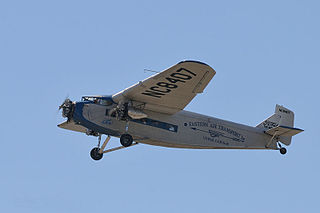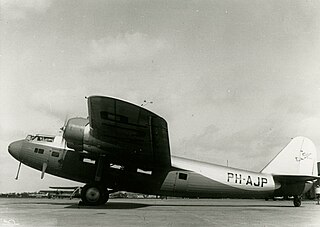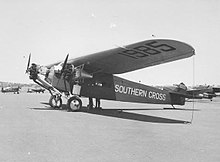
The Junkers Ju 52/3m is a transport aircraft that was designed and manufactured by German aviation company Junkers. First introduced during 1930 as a civilian airliner, it was adapted into a military transport aircraft by Germany's Nazi regime, who exercised power over the company, for its war efforts over the objections of the company's founder Hugo Junkers.

The Ford Trimotor is an American three-engined transport aircraft. Production started in 1925 by the companies of Henry Ford and ended on June 7, 1933, after 199 had been made. It was designed for the civil aviation market, but also saw service with military units.

The Lockheed Model 14 Super Electra was an American civil passenger and cargo aircraft built by the Lockheed Aircraft Corporation during the late 1930s. An outgrowth of the earlier Model 10 Electra, the Model 14 was also developed into larger, more capable civil and military versions.

The Avro 618 Ten or X was a passenger transport aircraft of the 1930s. It was a licensed version by Avro of the Fokker F.VIIB/3m.

The Fokker F.VIII was a large twin-engined airliner designed and produced by the Dutch aircraft manufacturer Fokker in the 1920s.

The Fokker F-10 was an enlarged development of the Fokker F.VII airliner, built in the late 1920s by the Fokker Aircraft Corporation of America. It was a trimotor passenger aircraft, and it carried 12 passengers. This was four more than the F.VII it was based on, and it had a larger wing and more powerful engines then that design. A crash of this aircraft in 1931, lead to widespread reforms in the U.S. aviation industry and hurt the reputation of wooden winged' aircraft, especially the Fokker Tri-motor types.

The Fokker F.IX was an airliner developed in the Netherlands in the late 1920s, intended to provide KLM with an aircraft suitable for regular services to the Dutch East Indies. When the onset of the Great Depression forced the postponement of those plans, the market for this aircraft disappeared as well, although it did see military service in Czechoslovakia as a bomber.

The Fokker F.XX was a 1930s Dutch three-engined airliner designed and built by Fokker. It was the first Fokker design to use an elliptical-section fuselage instead of the traditional square fuselage and the first Fokker aircraft with retractable landing gear.

The Fokker F.XXII was a 1930s Dutch four-engined 22-passenger airliner designed and built by Fokker.

The Fokker F.XXXVI was a 1930s Dutch four-engined 32-passenger airliner designed and built by Fokker. It was the largest transport designed and built by Fokker. Only one was built, and it was used for some commercial routes starting in 1935, and later aviation training by the British Royal Air Force until 1940.
Det Danske Luftfartselskab A/S or DDL, trading in English as Danish Air Lines, was Denmark's national airline from 1918 until it merged to create Scandinavian Airlines System (SAS) in 1951. DDL was established on 29 October 1918, but started its first scheduled route on 7 August 1920.

The Fairchild FC-1 and its derivatives were a family of light, single-engine, high-wing utility monoplanes produced in the United States in the 1920s and 1930s. The aircraft was originally designed to provide a camera platform for Sherman Fairchild's aerial photography and survey business, Fairchild Aerial Surveys.

The Fokker F.XVIII was an airliner produced in the Netherlands in the early 1930s, essentially a scaled-up version of the Fokker F.XII intended for long-distance flights. Like its predecessor, it was a conventional high-wing cantilever monoplane with fixed tailwheel undercarriage. Its cabin could seat 12 passengers, or four-to-six on seats convertible to sleeping berths. Only five were built, all for KLM, and registered as PH-AIO, 'AIP, 'AIQ, 'AIR and 'AIS, all of which were named after birds. Used by KLM on its Amsterdam-Batavia route, the F.XVIII became celebrated in the Netherlands due to two especially noteworthy flights. In December 1933, one aircraft was used to make a special Christmas mail flight to Batavia, completing the round trip in a flight time of 73 hours 34 minutes. The following Christmas, another F.XVIII made a similar flight to Curaçao in 55 hours 58 minutes after having been specially re-engined for the journey.

The Fokker F.XIV was a cargo plane built in the Netherlands in the late 1920s by Fokker. It was a high-wing cantilever monoplane of conventional trimotor layout. The sole example was tested by KLM but never put into service.

The PZL.4 was a Polish three-engine passenger aircraft for 10 passengers, built in PZL factory in 1932, which remained a prototype. It was the first Polish-designed and produced multi-engine plane.

The Wright R-790 Whirlwind was a series of nine-cylinder air-cooled radial aircraft engines built by Wright Aeronautical Corporation, with a total displacement of about 790 cubic inches (12.9 L) and around 200 horsepower (150 kW). These engines were the earliest members of the Wright Whirlwind engine family.
The Stout 3-AT trimotor was the first all-metal trimotor built in America. The poorly performing tri-motor led to an updated design which became the popular Ford Tri-Motor.

The Douglas DC-2 is a 14-passenger, twin-engined airliner that was produced by the American company Douglas Aircraft Company starting in 1934. It competed with the Boeing 247. In 1935, Douglas produced a larger version called the DC-3, which became one of the most successful aircraft in history.

On 24 July 1928, KLM-owned Fokker F.III H-NABR was a passenger sightseeing flight from and back to Waalhaven Airport, in Rotterdam, Netherlands. The plane with the pilot and five passengers on board stalled on takeoff and crashed after it struck boats in the Waalhaven harbour next to the airport. One passenger died after not all passengers could be saved in time while the airplane sank.





































